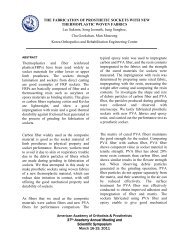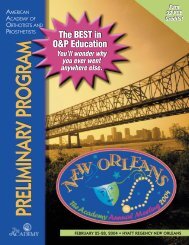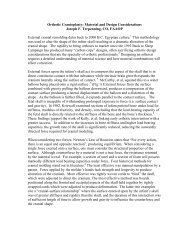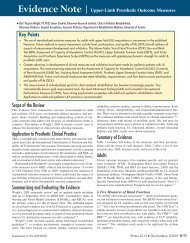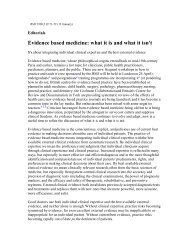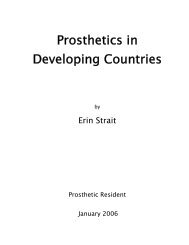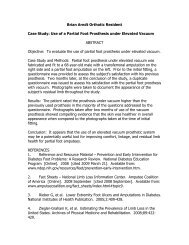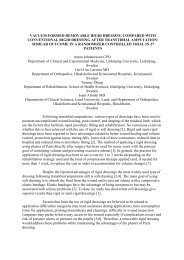Evidence Note: The Use of KAFOs and HKAFOs for Ambulation
Evidence Note: The Use of KAFOs and HKAFOs for Ambulation
Evidence Note: The Use of KAFOs and HKAFOs for Ambulation
You also want an ePaper? Increase the reach of your titles
YUMPU automatically turns print PDFs into web optimized ePapers that Google loves.
as required, use <strong>of</strong> unilateral H<strong>KAFOs</strong> is rare <strong>and</strong> limited to<br />
short-term application following hip arthroplasty to allow <strong>for</strong><br />
protected walking. 3 <strong>The</strong> principal impairments addressed by<br />
<strong>KAFOs</strong> are paresis or paralysis <strong>of</strong> the muscles controlling the<br />
knee joint, upper motor-neuron lesions resulting in hypertonicity<br />
(spasticity) <strong>of</strong> the lower limb, or loss <strong>of</strong> structural integrity <strong>of</strong> the<br />
hip or knee joints. A literature review <strong>of</strong> <strong>KAFOs</strong> <strong>and</strong> H<strong>KAFOs</strong><br />
<strong>for</strong> ambulation indicated that KAFO users include children<br />
with Duchenne muscular dystrophy (DMD) <strong>and</strong> persons with a<br />
diagnosis <strong>of</strong> polio, post-polio syndrome, or stroke; while users<br />
<strong>of</strong> H<strong>KAFOs</strong> include adults with SCI or paraplegia <strong>and</strong> children<br />
with myelomeningocele. 29<br />
Clinical Effectiveness<br />
Three systematic reviews regarding the use <strong>of</strong> <strong>KAFOs</strong> <strong>and</strong><br />
H<strong>KAFOs</strong> <strong>for</strong> ambulation were identified. 30–32<br />
As part <strong>of</strong> the Spinal Cord Injury Rehabilitation <strong>Evidence</strong><br />
project, Lam et al. 32 reviewed 14 studies that reported the<br />
effects <strong>of</strong> gait training with <strong>KAFOs</strong> <strong>and</strong> H<strong>KAFOs</strong> in people with<br />
complete <strong>and</strong> incomplete SCI, <strong>and</strong> seven studies that examined<br />
the combined effect <strong>of</strong> RGOs <strong>and</strong> functional electrical<br />
stimulation (FES) on functional ambulation in people with<br />
complete SCI. <strong>The</strong>y concluded that limited evidence suggests<br />
the benefits <strong>of</strong> orthotic management alone on functional<br />
ambulation are primarily <strong>for</strong> people with incomplete spinal<br />
lesions. <strong>The</strong> advantages <strong>of</strong> orthotic management are primarily<br />
the general health <strong>and</strong> well-being benefits related to st<strong>and</strong>ing<br />
<strong>and</strong> ambulating short distances in the home or indoor settings.<br />
<strong>The</strong>re is limited evidence that a combined approach <strong>of</strong> orthoses<br />
<strong>and</strong> FES results in additional benefit to functional ambulation in<br />
paraplegic patients with complete SCI. 32<br />
Ijzerman et al. 30 reviewed 12 comparative trials <strong>of</strong> H<strong>KAFOs</strong><br />
with <strong>and</strong> without FES <strong>for</strong> adults with complete thoracic lesions<br />
<strong>and</strong> reported that all the studies were internally invalid due to<br />
inadequate study design (simple within-subject comparisons<br />
without r<strong>and</strong>omization <strong>of</strong> orthosis testing order) <strong>and</strong> lack <strong>of</strong><br />
statistical power (small, heterogenous study populations).<br />
Bakker et al. 31 reviewed nine controlled <strong>and</strong> uncontrolled<br />
clinical trials <strong>and</strong> case studies regarding intervention with<br />
<strong>KAFOs</strong> <strong>for</strong> children with DMD. <strong>The</strong>y also noted that the<br />
scientific strength <strong>of</strong> the reviewed studies was poor but<br />
nevertheless concluded that use <strong>of</strong> <strong>KAFOs</strong> in the management<br />
<strong>of</strong> DMD can prolong assisted walking <strong>and</strong> st<strong>and</strong>ing. It<br />
remained uncertain whether <strong>KAFOs</strong> prolong “functional<br />
walking” because most studies were vague on what constitutes<br />
functional walking.<br />
In 2006, the American Academy <strong>of</strong> Orthotists <strong>and</strong> Prosthetists<br />
(the Academy) held a state <strong>of</strong> the science conference on the<br />
use <strong>of</strong> <strong>KAFOs</strong> <strong>and</strong> H<strong>KAFOs</strong> to assist with ambulation (SSC7). 33<br />
<strong>The</strong> literature review <strong>for</strong> this meeting identified two r<strong>and</strong>omized<br />
control trials <strong>and</strong> included 27 cross-sectional studies published<br />
between 1995 <strong>and</strong> 2004. 29 <strong>The</strong> review concluded that though<br />
<strong>Evidence</strong> <strong>Note</strong><br />
Copyright © 2009 American Academy <strong>of</strong> Orthotists <strong>and</strong> Prosthetists<br />
a reasonable amount <strong>of</strong> literature had been written regarding<br />
<strong>KAFOs</strong> <strong>and</strong> H<strong>KAFOs</strong>, the level <strong>of</strong> evidence regarding their use<br />
<strong>for</strong> ambulation was generally low. 29 <strong>The</strong>re was some evidence<br />
that use <strong>of</strong> H<strong>KAFOs</strong> diminishes with time in both adults <strong>and</strong><br />
children with paraplegia <strong>and</strong> that when orthoses are used, they<br />
are used mostly <strong>for</strong> therapeutic purposes. 11, 34–37 <strong>The</strong>re was also<br />
some evidence that walking speed is slow <strong>and</strong> energy cost high<br />
in people with paraplegia regardless <strong>of</strong> orthotic device used. 12,<br />
28, 38–46<br />
<strong>The</strong>re are as yet no reviews regarding stance-control orthoses<br />
(SCOs). 29 To date, there have been seven cross-sectional<br />
studies, 5–7, 47–50 ten case studies, 4, 51–59 <strong>and</strong> two technical<br />
notes. 60, 61 Three have evaluated gait with the Horton’s Stance<br />
Control Orthotic Knee Joint (SCOKJ), 4, 6, 55 six describe<br />
development <strong>and</strong> evaluation <strong>of</strong> the dynamic knee-brace<br />
system (DKBS), 5, 49, 50, 53, 54, 62 <strong>and</strong> two describe development<br />
<strong>and</strong> application <strong>of</strong> an electromechanical stance-control KAFO<br />
(SCKAFO). 57, 63 A single case study describes attempts to<br />
combine stance-control joints with an RGO. 58 <strong>The</strong> majority <strong>of</strong><br />
these studies have been in able-bodied persons or persons<br />
with unilateral limb weakness resulting from conditions such as<br />
polio. Preliminary studies suggest that providing stance control<br />
may decrease compensatory maneuvers (vaulting, hip hiking)<br />
<strong>and</strong> energy expenditure compared to walking with a locked<br />
4–7, 47, 51, 53, 55, 57<br />
knee.<br />
Safety<br />
It is recommended that qualified orthotists should contribute to<br />
the assessment <strong>and</strong> prescription <strong>of</strong> orthoses <strong>and</strong> be specifically<br />
responsible <strong>for</strong> manufacture <strong>and</strong> delivery <strong>of</strong> orthotic devices. 64<br />
An orthotist is an allied health pr<strong>of</strong>essional who is specifically<br />
trained <strong>and</strong> educated to provide or manage the provision <strong>of</strong><br />
a custom-designed, fabricated, modified, <strong>and</strong> fitted external<br />
orthosis to a patient. 65 Practitioners who successfully complete<br />
the education, experience, <strong>and</strong> examination requirements<br />
prescribed by an accrediting body become certified orthotists.<br />
Certification indicates that the orthotist has met established<br />
st<strong>and</strong>ards <strong>and</strong> has the qualifications required to render orthotic<br />
services. A certified orthotist is the best person to ensure safe<br />
provision <strong>and</strong> use <strong>of</strong> a KAFO or HKAFO.<br />
Economic Implications<br />
No published studies examining the cost effectiveness <strong>of</strong> <strong>KAFOs</strong><br />
<strong>and</strong> H<strong>KAFOs</strong> were identified. A review <strong>of</strong> Medicare payment<br />
data <strong>for</strong> 2007 66 shows that the allowable base rate <strong>of</strong> a single<br />
custom-fabricated KAFO ranged from $734–$3,289, while the<br />
allowable cost <strong>for</strong> an RGO was approximately $8,306 using the<br />
suggested coding <strong>for</strong> an ARGO 67 as an example.<br />
Future Research<br />
Designing adequate studies to investigate the effect <strong>of</strong><br />
<strong>KAFOs</strong> <strong>and</strong> H<strong>KAFOs</strong> on ambulation is challenging due<br />
to the heterogeneous populations that use these devices<br />
<strong>and</strong> the heterogeneity within each population. It has been<br />
recommended that r<strong>and</strong>omized crossover interrupted time<br />
A-10 <strong>The</strong> Academy TODAY ■ February 2010 Supplement <strong>of</strong> <strong>The</strong> O&P EDGE



